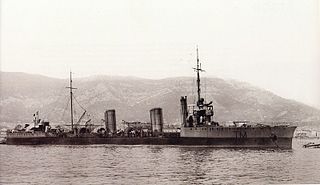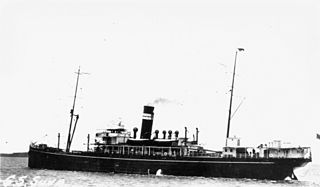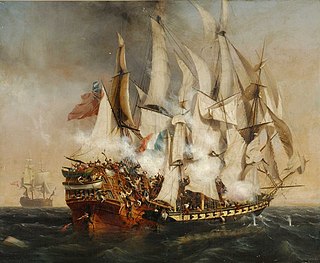
An armed merchantman is a merchant ship equipped with guns, usually for defensive purposes, either by design or after the fact. In the days of sail, piracy and privateers, many merchantmen would be routinely armed, especially those engaging in long distance and high value trade.

Robert Surcouf was a French privateer who operated in the Indian Ocean between 1789 and 1801, and again from 1807 to 1808, capturing over 40 prizes, while amassing a large fortune as a ship-owner, from both privateering and commerce.

The Battle of the Basque Roads, also known as the Battle of Aix Roads was a major naval battle of the Napoleonic Wars, fought in the narrow Basque Roads at the mouth of the Charente River on the Biscay coast of France. The battle, which lasted from 11–25 April 1809, was unusual in that it pitted a hastily-assembled squadron of small and unorthodox British Royal Navy warships against the main strength of the French Atlantic Fleet, the circumstances dictated by the cramped, shallow coastal waters in which the battle was fought. The battle is also notorious for its controversial political aftermath in both Britain and France.

Louis Edouard Bouët-Willaumez was a French admiral.

Poursuivante ("chaser") was a Romaine class frigate of the French Navy.

En flûte is a French naval expression of the Age of Sail to designate the use of a warship as a transport with a reduced armament.

HMS Amethyst was a Royal Navy 36-gun Penelope-class fifth-rate frigate, launched in 1799 at Deptford. Amethyst served in the French Revolutionary Wars and the Napoleonic Wars, capturing several prizes. She also participated in two boat actions and two ship actions that won her crew clasps to the Naval General Service Medal. She was broken up in 1811 after suffering severe damage in a storm.

The Atlantic campaign of 1806 was one of the most important and complex naval campaigns of the post-Trafalgar Napoleonic Wars. Seeking to take advantage of the withdrawal of British forces from the Atlantic in the aftermath of the Battle of Trafalgar, Emperor Napoleon ordered two battle squadrons to sea from the fleet stationed at Brest, during December 1805. Escaping deep into the Atlantic, these squadrons succeeded in disrupting British convoys, evading pursuit by British battle squadrons and reinforcing the French garrison at Santo Domingo. The period of French success was brief: on 6 February 1806 one of the squadrons, under Vice-Admiral Corentin Urbain Leissègues, was intercepted by a British squadron at the Battle of San Domingo and destroyed, losing all five of its ships of the line.

The Atlantic campaign of 1806 was a complicated series of manoeuvrees and counter-manoeuveres conducted by squadrons of the French Navy and the British Royal Navy across the Atlantic Ocean during the spring and summer of 1806, as part of the Napoleonic Wars. The campaign followed directly from the Trafalgar campaign of the year before, in which the French Mediterranean fleet had crossed the Atlantic, returned to Europe and joined with the Spanish fleet. On 21 October 1805, this combined force was destroyed by a British fleet under Lord Nelson at the Battle of Trafalgar, although the campaign did not end until the Battle of Cape Ortegal on 4 November 1805. Believing that the French Navy would not be capable of organised resistance at sea during the winter, the First Lord of the Admiralty Lord Barham withdrew the British blockade squadrons to harbour. Barham had miscalculated – the French Atlantic fleet, based at Brest, had not been involved in the Trafalgar campaign and was therefore at full strength. Taking advantage of the reduction in the British forces off the port, Napoleon ordered two heavy squadrons to sea, under instructions to raid British trade routes while avoiding contact with equivalent Royal Navy forces.

The Action of 9 July 1806 was a minor engagement between a French privateer frigate and British forces off Southern Ceylon during the Napoleonic Wars. French privateers operating from the Indian Ocean islands of Île Bonaparte and Île de France were a serious threat to British trade across the Indian Ocean during the Wars, and the British deployed numerous methods of intercepting them, including disguising warships as merchant vessels to lure privateers into unequal engagements with more powerful warships. Cruising near the Little Basses Reef on the Southern coast of Ceylon, the 34-gun privateer Bellone was sighted by the 16-gun British brig HMS Rattlesnake, which began chasing the larger French vessel. At 15:15, a third ship was sighted to the south, which proved to be the 74-gun ship of the line HMS Powerful, disguised as an East Indiaman.

The Battle of Les Sables-d'Olonne was a minor naval battle fought on 23 February 1809 off the town of Les Sables-d'Olonne on the Biscay Coast of France between a French Navy squadron of three frigates and a larger British squadron of ships of the line. The French squadron had sailed from the port of Lorient on 23 February in an effort to link up with a fleet from Brest under Jean-Baptiste Willaumez, but missed the rendezvous and was pursued by a British blockade squadron under Rear-Admiral Robert Stopford. The French commander, Commodore Pierre Roch Jurien, anchored his squadron under the batteries which protected the town of Les Sables-d'Olonne in the hope of dissuading an attack.

The Aventurier-class destroyers were a group of four destroyers of the French Navy built during the early 1910s. They were built by the Ateliers et Chantiers de Bretagne in Nantes and the Dyle & Bacalan Shipyard in Bordeaux. Originally ordered by Argentina, they were taken over by the French on the outbreak of the First World War in August 1914, completed with French armament and renamed.

An armed boarding steamer was a merchantman that during World War I the British Royal Navy converted to a warship. AB steamers or vessels had the role of enforcing wartime blockades by intercepting and boarding foreign vessels. The boarding party would inspect the foreign ship to determine whether to detain the ship and send it into port, or permit it to go on its way.

The Action of 28 June 1803 marked the opening shots of the Blockade of Saint-Domingue after the collapse of the Treaty of Amiens and the outbreak of the War of the Third Coalition in May 1803.

Jacques Bergeret was a French naval officer and admiral.
Joseph Potier was a French privateer and slave trader. He was one of the lieutenants of Robert Surcouf.

Confiance, launched in 1797, was a privateer corvette from Bordeaux, famous for being Robert Surcouf's ship during the capture of the British East India Company's East Indiaman Kent. The British Royal Navy captured Confiance in 1805, took her into service under her existing name, and sold her in 1810. Before she was sold, Confiance took part in two notable actions.
Italienne was a 40-gun Consolante-class frigate of the French Navy, built by engineer Denais after plans designed by Sané and revised by François Pestel. Under Commander Jurien de La Gravière, she took part in the Battle of Les Sables-d'Olonne, where she sustained very severe damage.
Calypso was a 40-gun Gloire-class frigate of the French Navy, built after plans designed by Sané revised by Forfait. Under Captain Louis-Léon Jacob, she took part in the Battle of Les Sables-d'Olonne, where she sustained very severe damage.

















